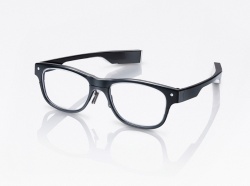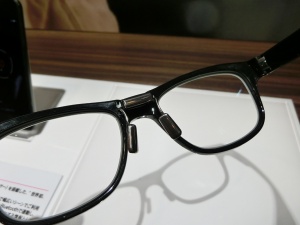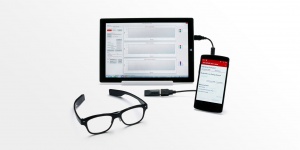Jins Meme
| JINS MEME | |
|---|---|

|
|
| Category | smartglasses |
| Developer | JIN Co., Ltd. [1] |
| Announced | May 2014 [2] |
| Released | Developers: April 2015 [3]
Consumers: 5 November 2015 (iOS)[4], January 2016 (Android)[5] |
| Price | 324 USD (Dec 2015)[6] |
| Operating system | unknown |
| Display | none |
| Resolution | none |
| Field of view | |
| Weight | 36 g [7] |
| Controls |
smartphone, inertial, buttons, electrooculography |
| Data available | Good |
| Risk factor | Low |
| Not Standalone | |
| https://www.jins-jp.com/jinsmeme/en/ | |
Jins MEME are ordinarily looking glasses designed and developed by a Japanese eyewear company Jins. They are not strictly speaking a head-mounted display as they do not have any displaying capability, nor does it feature any cameras. The frames of the glasses features a set of sensors that measures the position of the glasses and the electric potential of the wearer's eyes. The ability to analyse the eye movements is the main selling point of the glasses, the company markets the glasses to drivers.[8] The eye-tracking can help prevent microsleep by warning the driver early for example.[9] It can also track the user's posture.[10] The device is not able to process the recorded data by itself and has to be connected to a smartphone to fully function. This is achieved by a Bluetooth connection.
The company also has an academic pack available to research institutions.[11] According to Jins, the glasses are "world’s first scientifically-proven wearable eyewear." The academic pack features two Jins MEME glasses, as well as other items such as manual, adapter and so on,[12] which now allow potential researchers to extract the raw data from the sensors directly, without an API.
Contents
Main characteristics
The device greatly resembles a pair of normal glasses as all of the electronics is hidden on the glasses' frame. The device does not feature any display or projectors. It also does not have a camera. The available sensors are an accelerometer, gyroscope, and an electrooculography sensor housed in the bridge of the glasses. The frame is thicker at the ends so there is space for the battery with indicated life of 16 hours on one charge. The device also feature a Bluetooth antenna for connectivity.[13]
Jins MEME do not run any operating system and have to be paired with a smartphone to process and store the gathered data. For this, the company made a custom app available. So far the app only gathers and display the data but the company plans on expanding the features with future add-ons after the device release in 2016.[14]
Purpose
Jins MEME is a head-mounted device that gathers data about the eye movements and position of the head of its wearer. It does not feature a display nor a camera. The recorded data can be stored and analysed in a connected smartphone. This information can be used to inform the user about their mental state, fatigue, and body posture. Jins Meme can also be used as a control device. Several official apps are available.[15]
Company & People
JIN CO., LTD. is a Tokyo, Japan, based retailer and developer of eyewear and other types of fashion merchandise.[16]
- Hitoshi Tanaka - Founder and CEO
- Kazutaka Inoue - Director of the Jins Meme division
- Seiichi Saito - Creative and Technical Director
- Kentaro Shihaku - Creative Director
"We have challenged the historical limitations of eyewear, introducing a range of innovative glasses that move beyond vision correction to help solve problems of daily life.” - Hitoshi Tanaka, Interview for Wareable magazine[17]
Important Dates
- May 2014 - JIN CO. announces Jins MEME during CES 2015.[2]
- April 2105 - JIN launches the Academic Pack, a package of Jins MEME glases, software, and relevant accessories for researchers.[3]
- January 2016 - Scheduled date of the consumer version release.
Enhancement/Therapy/Treatment
Enhancement - As Hitoshi Tanaka, the CEO and the founder of JIN CO., stated, the ultimate goal of Jins Meme is to improve and enhance the lives of its wearers. The data from the sensors can be utilized to enhance sport activities as well as to improve body posture and attention.
Treatment - Jins Meme can be potentially used to prevent or remedy the symptoms of Parkinson's disease or dementia by "nudging people into using their brains more."[18] This is especially important in countries troubled with population ageing such as Japan.
Ethical & Health Issues
There are no ethical or health issues connected to this particular device.
For more general issues connected with smartglasses, please see the Smartglasses synopsis.
Public & Media Impact and Presentation
First articles from western media came out just (December 2014) before CES 2015.[19] Wareable magazine said about Jins Meme that it is an "alternative to Google Glass" and discussed the electrooculography sensor and JIN CO. vision (see quote in Company & People) regarding smartglasses. Similar article appeared in Digital Trends.[20] The article focuses on the looks of the device, calls it "innocent looking" and makes a positive remark that it "could be the future of smart eyewear."[21] Interestingly, attention to the fact that Jins Meme does not look like other emerging smartglasses device is visible in other articles very often.
The device received great attention after it was officially introduced to western media on CES 2015 in January. In an article titled "Glassholes would get punched less wearing Jins subtle Meme smart glasses" Digital Trends made a comparison to Google Glass and praised the subtle looking design of the device. The author was impressed by the electrooculography sensor and called the device to be overall "subtle but powerful."[22] An article on CNET again mentions how "normal" the device looks. It mentions that the device can help prevent eye-fatigue. The author was clearly impressed by the device and summarised his feeling by calling it "something you'd actually want to wear."[23]
Eastern media informed about the device as well. RocketNews24 made a comparison to fitness wearables and writes that the device can help its users with their sport performance. It also discusses the effects of the device on mental state. The author muse over whether Jins Meme can "transform [us] into better version of ourselves."[24] Asian Review also mentions fitness and health tracking applications. The author makes a comparison to other fitness trackers and also discusses the possibility to use the device in prevention of mental illnesses like dementia or Parkinson's disease.[18] Japanese Engadget discusses the specifications of the device. It raises a point about how comfortably the nose bridge can fit people with differently shaped noses as the electrodes of the sensor have to be firmly pressed on the skin for accurate measurement. The author also states that the device feels slightly heavy but likes the design and fit of the glasses overall.[4] IT Media HealthCare praises the device for their ordinary design. It discusses the ease of use of the official mobile app but also mentions that the app, so far, only displays recorded data.[25]
Public Policy
There is no public policy that considers this device specifically.
For more information about policies related to smartglasses, please see the Smartglasses synopsis.
Related Technologies, Projects or Scientific Research
The company offers an extensive academic package to researches who wish to use the device in their research. There are several papers linked on the official website that deal with topics such as activity recognition[26], healthy habit promotion[27], and reading speed.[28]
Other papers discussing the development of the device are also available.[29]
References
- ↑ http://www.jin-co.com/en/
- ↑ 2.0 2.1 http://engineer.typemag.jp/article/jins-meme
- ↑ 3.0 3.1 http://www.prnewswire.com/news-releases/jin-to-launch-jins-meme-academic-pack-in-late-april-2015-300002000.html
- ↑ 4.0 4.1 http://japanese.engadget.com/2015/10/14/60-jins-meme/
- ↑ https://jins-meme.com/en/collection/compare/
- ↑ https://www.jins-jp.com/Payment/Cart
- ↑ https://www.jins-jp.com/jinsmeme/en/product/
- ↑ https://jins-meme.com/en/drive/
- ↑ http://www.wired.co.uk/news/archive/2015-01/09/jins-meme-smart-glasses
- ↑ https://jins-meme.com/en/fitness/
- ↑ https://jins-meme.com/en/academic/
- ↑ https://jins-meme.com/en/academic/service/
- ↑ https://jins-meme.com/en/academic/specifications/
- ↑ http://healthcare.itmedia.co.jp/hc/articles/1512/05/news013.html
- ↑ https://jins-meme.com/en/apps/
- ↑ http://www.bloomberg.com/quote/3046:JP
- ↑ http://www.wareable.com/smartglasses/jins-meme-smartglasses-to-get-western-exposure-at-ces-629
- ↑ 18.0 18.1 http://asia.nikkei.com/magazine/20151105-ASEAN-INC.-S-GLOBAL-PUSH/Tech-Science/Keep-an-eye-on-your-health-with-Jins-Meme-glasses?page=2
- ↑ http://www.wareable.com/smartglasses/jins-meme-smartglasses-to-get-western-exposure-at-ces-629
- ↑ http://www.digitaltrends.com/wearables/jins-meme-smart-eyewear-news/
- ↑ http://www.digitaltrends.com/wearables/jins-meme-smart-eyewear-news/
- ↑ http://www.digitaltrends.com/wearables/jins-meme-hands-on/
- ↑ http://www.cnet.com/products/jins-meme/
- ↑ http://en.rocketnews24.com/2015/10/17/jins-meme-award-winning-glasses-track-your-physical-state-and-concentration-levels/
- ↑ http://healthcare.itmedia.co.jp/hc/articles/1512/05/news013.html
- ↑ ISHIMARU, Shoya, et al. Smart Eyewear for Interaction and Activity Recognition. In: Proceedings of the 33rd Annual ACM Conference Extended Abstracts on Human Factors in Computing Systems. ACM, 2015. p. 307-310. Available online at: https://jins-meme.com/download_common.php?f=academic/1402/Smart_Eyewear_for_Interaction_and_Activity_Recognition.pdf
- ↑ KUNZE, Kai, et al. MEME: smart glasses to promote healthy habits for knowledge workers. In: ACM SIGGRAPH 2015 Emerging Technologies. ACM, 2015. p. 17. Available online at: https://jins-meme.com/download_common.php?f=academic/1403/MEME_smart_glasses_to_promote_healthy_habits_for_knowledge_workers.pdf
- ↑ KUNZE, Kai, et al. How much do you read?: counting the number of words a user reads using electrooculography. In: Proceedings of the 6th Augmented Human International Conference. ACM, 2015. p. 125-128. Available online at: https://jins-meme.com/download_common.php?f=academic/1404/How_much_do_you_read_counting_the_number_of_words_a_user_reads_using_electrooculography.pdf
- ↑ KANOH, S., et al. Development of an eyewear to measure eye and body movements. In: Engineering in Medicine and Biology Society (EMBC), 2015 37th Annual International Conference of the IEEE. IEEE, 2015. p. 2267-2270.


